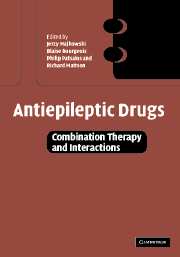Book contents
- Frontmatter
- Contents
- List of contributors
- Foreword
- Foreword
- Acknowledgements
- Part I Introduction
- Part II Pharmacokinetic interactions
- Part III Pharmacodynamic interactions
- 9 Pharmacodynamic principles and mechanisms of drug interactions
- 10 Methods for assessing pharmacodynamic interactions
- 11 Experimental studies of pharmacodynamic interactions
- 12 Clinical studies of pharmacodynamic interactions
- 13 Clinical studies of pharmacodynamic interactions between antiepileptic drugs and other drugs
- Part IV Drug interactions in specific patient populations and special conditions
- Part V Conclusions and future perspectives
- Index
11 - Experimental studies of pharmacodynamic interactions
from Part III - Pharmacodynamic interactions
Published online by Cambridge University Press: 07 September 2009
- Frontmatter
- Contents
- List of contributors
- Foreword
- Foreword
- Acknowledgements
- Part I Introduction
- Part II Pharmacokinetic interactions
- Part III Pharmacodynamic interactions
- 9 Pharmacodynamic principles and mechanisms of drug interactions
- 10 Methods for assessing pharmacodynamic interactions
- 11 Experimental studies of pharmacodynamic interactions
- 12 Clinical studies of pharmacodynamic interactions
- 13 Clinical studies of pharmacodynamic interactions between antiepileptic drugs and other drugs
- Part IV Drug interactions in specific patient populations and special conditions
- Part V Conclusions and future perspectives
- Index
Summary
Introduction
In most patients, the therapy of newly diagnosed epilepsy is initiated with a single antiepileptic drug. Approximately 60–70% of patients may experience a reasonable seizure control with monotherapy (Sander et al., 1993; Czuczwar and Patsalos, 2001). However, monotherapy is not sufficient for the remainder of epileptic patients. Therefore, experimental background information may be helpful for an epileptologist to know what drug combinations can be considered preferentially for combination therapy or for controlled clinical trials. Animal studies evaluate the combinations of conventional antiepileptic drugs or combinations of a conventional antiepileptic drug with a novel (or potential) antiepileptic drug. The protective effect of a drug combination may be quantified with the isobolographic method on the basis of equieffective doses of individual drugs administered alone or in combination (Tallarida, 1992; Tallarida et al., 1989). An alternative method evaluates the effect of one antiepileptic drug given in sub-protective doses upon the ED50 value (the effective dose of a drug necessary to protect 50% of the animals) of another drug against experimental seizures. The ED50 value of the second drug in combination with sub-protective doses of the first antiepileptic drug is compared to the control ED50 value, estimated for the second drug alone, according to the method of Litchfield and Wilcoxon (1949).
Interactions between conventional antiepileptic drugs
As already mentioned, the experimental background may provide clues regarding which drug combinations may actually have a significant therapeutic potential. There have been many experimental studies dealing with combinations of conventional antiepileptic drugs.
Keywords
- Type
- Chapter
- Information
- Antiepileptic DrugsCombination Therapy and Interactions, pp. 208 - 227Publisher: Cambridge University PressPrint publication year: 2005
- 1
- Cited by



